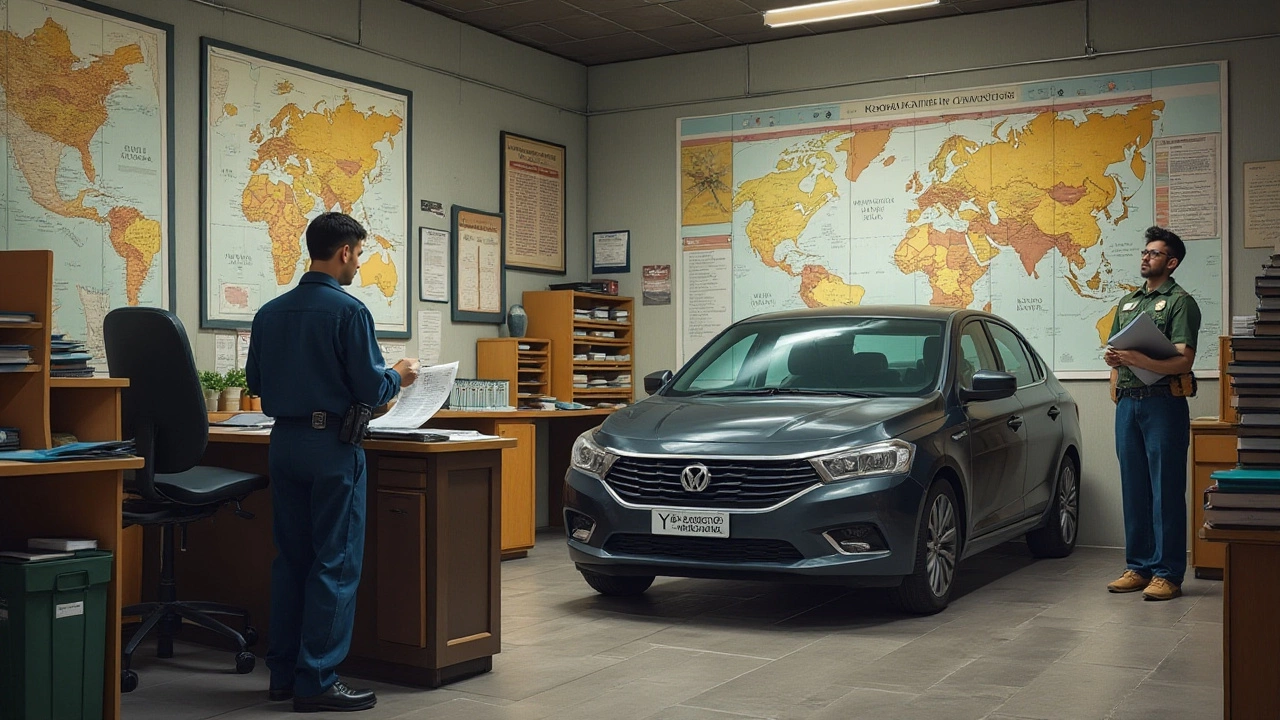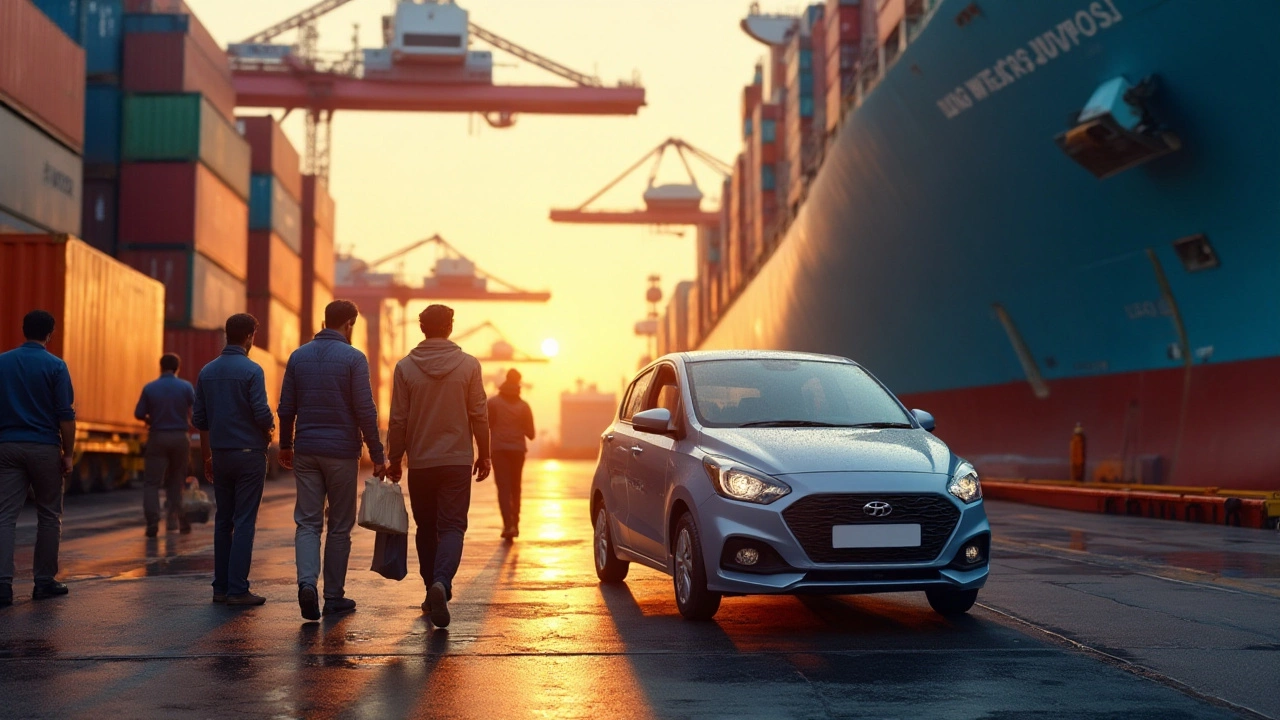Importing a car from India to the USA can be an intricate process, enveloped in many layers of regulation and paperwork. Given the unique allure that certain Indian models attract, enthusiasts might find this journey worth every bit of effort.
However, it's not just about shipping the car over; you have to dive deep into the US's stringent import rules, specifically those concerning emissions and safety standards. Starting this process requires thorough research and sometimes even specialist help to ensure everything is above board.
Trade routes and shipping logistics also play a vital role, impacting the cost and time involved. As the global automotive industry continues to evolve, the rules often shift, and staying informed is crucial for a successful import experience.
- Understanding US Import Regulations
- Ensuring Emissions and Safety Compliance
- The Role of Shipping and Logistics
- Costs Involved in Car Importation
- Tips for a Smooth Import Process
Understanding US Import Regulations
Stepping into the intricacies of importing cars from India to the USA, the first hurdle often faced revolves around understanding the comprehensive and often perplexing US import regulations. The allure of owning a unique Indian automobile can be great, but navigating through the maze of legal requirements is crucial. The US Customs and Border Protection (CBP) agency plays a vital role in this process. They are the gatekeepers, ensuring every vehicle enters the country legally. Cars must comply with the US standards set by agencies such as the Environmental Protection Agency (EPA) and the Department of Transportation (DOT).
The EPA focuses predominantly on emissions standards, casting a wide net to ensure that any imported automobile complies with stringent environmental guidelines. If your vehicle doesn't originally conform to these standards, the EPA does allow for alterations, but they must be performed by a recognized Independent Commercial Importer (ICI). Now, this isn't a simple bolt-on part scenario; it involves detailed and specific conversions that can often increase the cost significantly. Meanwhile, the DOT's main concern is safety standards, checking that all vehicles comply with the Federal Motor Vehicle Safety Standards (FMVSS). Meeting these standards is essential, as non-compliance can result in denial of entry into the US, or even the dreaded fate of re-exportation at the owner's expense.
"Noncompliance isn't an option," remarked a spokesperson from the DOT, emphasizing the importance of adherence to federal standards in an interview in 2022. "Our priority is consumer safety and environmental protection, and every imported vehicle must meet our requirements without exception."
Documentation is another field where attention to detail is paramount. Essential paperwork includes a properly filled HS-7 Declaration form, proving that the car complies with domestic regulations. An EPA Form 3520-1 is required as well, to demonstrate compliance with emissions standards. It is imperative to keep a close eye on the accuracy of this paperwork. Any errors, even if minor, can lead to substantial delays or even penalties. The documentation process may seem overwhelming, but meticulous organization and perhaps the guidance of a professional can help to avoid common pitfalls. A professional's insight into these processes, although an added expense, can considerably smooth out the procedure.
Another vital aspect is the time frame. Despite the era of digital automation, the paperwork and regulatory checks still take a fair amount of time. Patience, along with proactive communication with all parties involved—including shippers, customs officials, and any intermediaries—can make a significant difference. Occasionally, unexpected delays do occur, and while frustrating, understanding that this is part of the process can help maintain peace of mind. Importing a car is a complex project; one that demands thorough preparation, a keen understanding of the regulations, and an unwavering attention to detail.
Ensuring Emissions and Safety Compliance
When contemplating car import from India to the ~USA~, it's crucial to grasp the intricate details of emissions and safety standards. The United States has some of the strictest automobile regulations globally, designed to protect both the environment and drivers. A key agency, the Environmental Protection Agency (EPA), enforces emissions standards that every vehicle must meet. The National Highway Traffic Safety Administration (NHTSA) oversees safety aspects. Before deciding to import a vehicle, inquire about these standards and the vehicle's compliance capabilities in India. Many foreign models fall short of these stringent requirements, so ensuring compliance on time is vital.
Most Indian cars were designed with a different regulatory environment in mind, which means they often need modifications before they can grace American roads. This might include alterations to the vehicle's exhaust system, addition of certain safety features like airbags or reinforced bumpers, and adapting to different emission control systems. Engaging with a Registered Importer (RI) is usually a mandatory step, as they are well-versed in converting foreign vehicles to US standards. These specialists perform necessary modifications and guide you through the certification process, ensuring the vehicle adheres to all US regulations. An often-cited quote by the EPA states, "Compliance is not a one-time action but a continuous evolution," underlining the diligence required in this process.
To break down the inspection and certification path, vehicles undergo a rigorous inspection upon arrival. Only once they successfully pass this examination can they be legally driven. The process involves significant documentation, starting with the EPA Form 3520-1 and the Department of Transportation (DOT) HS-7 Declaration form. These are essential for clearing the import through customs. Be prepared for detailed checks, including for anti-theft systems, lighting, and seatbelt specifications, which often vary from US standards. If any part of this process is overlooked, it can lead to costly delays or even rejection at the border.
Financial implications play a significant role here. While some might assume it's all about the purchase price of the car, the expenses incurred in ensuring emissions and safety compliance can add up significantly. From hiring an RI to potential costs involving replacement parts and labor, having a clear understanding of these expenses is as essential as the compliance itself. It's not uncommon for these costs to rival or exceed the purchase price of the vehicle. Therefore, budgeting wisely from the get-go is highly recommended.
A practical tip is acquiring an emissions certification or a compliance letter from the manufacturer, if available. Such documents can expedite the process and make the inspection less of a hurdle. Also, study the EPA's list of non-compliant vehicles, updated yearly, to avoid models known for regulatory issues. Finally, it's beneficial to stay informed about any changes to emissions standards or safety regulations, as automobile policies can shift quickly in the US. This proactive approach will make the complex task of importing a more seamless endeavor.

The Role of Shipping and Logistics
Embarking on the venture of importing a car from India to the USA involves tackling the significant task of managing shipping and logistics. This process is not just about booking a vessel and securing a spot for your vehicle. It is a dynamic field requiring precision, expert knowledge, and a thorough understanding of international shipping procedures. The journey starts with selecting the right shipping method—whether to containerize the car or opt for the roll-on/roll-off (Ro-Ro) service. Containerized shipping often provides more protection but at a higher price. This method secures the car in a container, safeguarding it from potential damage during transport. On the other hand, Ro-Ro shipping is typically more economical, where cars are driven directly onto the vessel, albeit with less protection.
Before the shipping occurs, it’s crucial to engage with a reputable logistics company familiar with both Indian export and American import procedures. The chosen company will coordinate with various entities, from customs brokers who handle paperwork to port authorities at both ends. Proper logistics coordination includes ensuring that all necessary documents, such as the Bill of Lading and Import Declaration Form, are meticulously managed and adhered to. An error in documentation can lead to costly delays or legal issues at the customs checkpoint.
During the shipping planning phase, timing is essential. Seasons can impact shipping costs and schedules; for example, shipping during monsoon months in India might pose additional risks and delays, while peak trade seasons could mean longer waits at the port. Logistics firms often advise scheduling shipments during off-peak periods to avoid congestion and reduce costs. While transit to the USA, specifically to ports like New York, Los Angeles, or Houston, could take several weeks, real-time tracking offered by many logistics providers today gives peace of mind by allowing importers to monitor their vehicle's journey.
A reputable logistics partner also helps navigate the various regulations at the US border regarding emissions standards and modifications. For those new to automobile importation, seeking guidance on these technicalities is imperative. According to the Federal Motor Carrier Safety Administration, ensuring compliance with the Vehicle Importation Guidelines is a must for anyone hoping to make it past US borders smoothly.
“Understanding the precise logistical requirements and regulatory mandates can make or break the endeavor of importing a vehicle,” says John Tyler, a seasoned consultant in international trade logistics.
Costs Involved in Car Importation
Importing a car from India to the USA is not just about the purchase price of the vehicle; it is an entire adventure in expenses both predictable and unexpected. The very first cost you’ll encounter is the shipping fee, which generally hinges on the size and weight of the vehicle, as well as the distance it needs to cover. The vast ocean between India and the USA presents its own unique challenges, demanding robust transport methods that can run anywhere from $1,000 to $3,500 depending on these factors.
Beyond shipping, the US Customs Duty jumps into the picture as a major cost consideration. Typically, a duty of 2.5% is levied on most passenger cars. However, if you’re thinking of importing a truck, brace yourself for a 25% duty, which lands quite heavily on the wallet. Now, if you have a more luxurious taste and are considering sports utility vehicles (SUVs), expect the duties to be somewhere in between these figures, making strategic planning essential.
Another area that often catches importers off guard is the costs associated with ensuring the vehicle meets the stringent emissions and safety compliance standards in the USA. Extensive modifications might be necessary, ranging from adjusting the exhaust system to upgrading safety features to make the car road-legal in the USA. These tweaks can pile on additional costs between $5,000 and $10,000, though the exact amount depends on how far the original specifications deviate from American standards.
"Taking these costs into account early in the process can prevent unpleasant surprises," advises John Firenza, an import specialist with over two decades of experience working with automotive imports. "These are mission-critical steps that need precision and expertise."
In addition to the main expenses, you must keep an eye on smaller fees that collectively might impact your budget significantly. Port fees, for example, are another standard charge that you will have to cover once the car lands in the USA. These charges cater to handling the vehicle at the dock and can range from $100 to $500. Also, consider the cost of a customs broker who can greatly simplify the intricate documentation process, costing anywhere from $200 to $500, which many importers find worthwhile.
Finally, there's insurance, a necessary safeguard should any unforeseen events occur during the long maritime journey. Calculated based on the value of the vehicle, shipping insurance fees typically hover around 1.5% of the car's worth, ensuring peace of mind across the high seas.

Tips for a Smooth Import Process
Importing a car from India to the USA is a task that requires detailed planning and execution. This adventure isn't just about logistics though—they are crucial—but also about the regulations and finer nuances of international automobile trade. First things first, understanding the car import laws is essential. Begin by researching the specific laws and guidelines set by both Indian and US authorities related to automobile exports and imports. Remember, the US Customs and Border Protection (CBP) and the Environmental Protection Agency (EPA) have stringent prerequisites with compliance required at both ends. It’s worth noting that Indian cars need to meet the emissions and safety compliance rules of the US before they can hit the road. This often means retrofitting and modification to match US standards, an aspect that can influence both time and budget significantly.
As the legal groundwork unfolds, budgeting becomes a cornerstone. It's essential to detail every aspect of cost involved in the importation process. This includes costs for shipping, insurance, potential retrofitting for safety standards, and any customs duties. With these variables, it's wise to consult with financial experts who specialize in vehicle importation. They can provide insights that might not be immediately obvious, such as variable shipping rates dependent on season or geopolitical considerations. One pertinent piece of advice, as echoed by the National Auto Tourist Advisory Council, states,
'The devil is in the details when it comes to importing vehicles—each overlooked detail can add weeks to your timeline and thousands to your budget.'Undeniably, meticulous planning equals smoother execution.
The logistical aspect of exporting the car from India and importing it into the USA is another crucial step. Picking a reliable shipping company with a reputable background in international car shipments can make or break this experience. These companies not only have the equipment necessary but also the knowledge of regulations in different territories which simplifies the process. Shipping logistics aren't just about moving a car across the water; dockside handling at both ports, oversight of loading processes, and attention to detail with regards to transit times play a significant role. Be wary of ranking reliability over cost-saving; the cheaper options sometimes incur hidden delays or fees. Integrating insurance is also advisable—a move overlooked but can offset potential losses.
Patience and thorough communication enhance the likelihood of smooth transitions. Key players in this journey include the shipping company, customs brokerage, and possibly a legal advisor adept at international trade. Staying connected with each party ensures immediate attention to queries and quicker resolution of issues. It's akin to navigating a complex orchestra, where timing and fluid motion dictate seamless performance. Building a rapport with these stakeholders and extending courtesy from the start can pay dividends later when cooperation is required swiftly. For many importers, maintaining transparency throughout this process means fewer obstacles and a more predictable timeline.
Once the vehicle safely lands on American soil, document verification is paramount. This isn't just an administrative formality but a checkpoint ensuring every step adhered to legalities. At this stage, any discrepancies or overlooked forms could spell trouble. With documentation circles closed, begin balancing the rest of the owning process; this might entail state-specific registrations and insurance formalities. Here, local resources become useful. Engaging with Indian diasporic communities or automotive hobby groups that specialize in imported vehicles can offer valuable resource-sharing and insight. Many find that tapping into these networks unlocks a trove of hidden knowledge, ensuring not just a successful import but a rewarding relationship with their vehicle for years to come.
